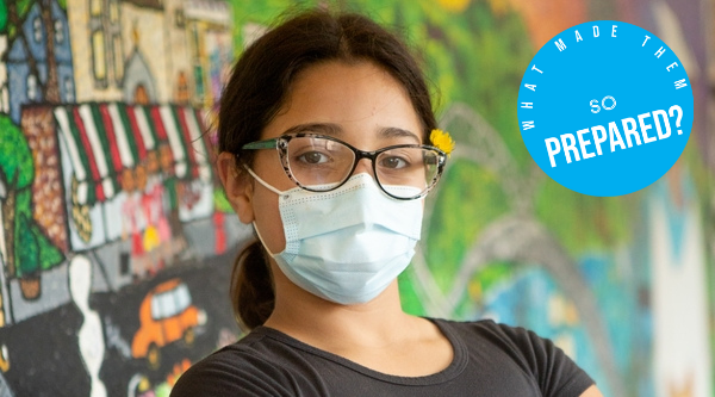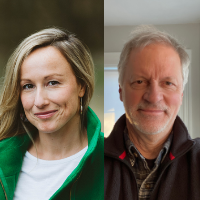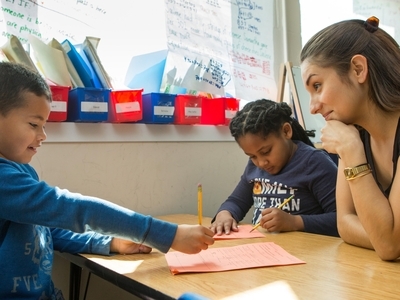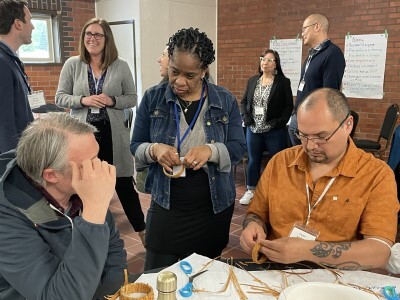This Epiphany Changed These Schools and Districts and the Lives of the Families They Serve. It Could Do the Same for You.
Topics

Next generation learning is all about everyone in the system—from students through teachers to policymakers—taking charge of their own learning, development, and work. That doesn’t happen by forcing change through mandates and compliance. It happens by creating the environment and the equity of opportunity for everyone in the system to do their best possible work.
What Made Them So Prepared?
A Project about K-12 Resilience
Is your school or district truly living your graduate profile? Among students and adults? If not: shouldn’t it? The stories of these schools’ response to COVID vividly demonstrate why.
As we emerge—sort of—from public education’s most challenging year ever, educators and whole communities are reflecting and seeking to understand what lessons we’ve learned and what that means for teaching and learning moving forward.
The global pandemic has been a crucible of the challenges today’s students will face over their lifetimes—and a high-pressure test of the schools and districts serving them. COVID presented every school in the world with challenges that required complex problem-solving, critical thinking, creativity, effective people management, high degrees of collaboration, good judgment, cognitive flexibility…. Exactly the “21st-century” skills we see named in many school and district visions of success for their graduates.
Some of these schools and districts see that vision—explicitly or not—as a set of attributes to be pursued, developed, and practiced throughout their community. They have worked hard, some for more than a decade, to develop adult working cultures and systems that align with their aspirations for kids. That of course makes every kind of sense: how are teachers working in a compliance-oriented system going to enable students to develop agency, initiative, and self-direction in any genuine way?
This year, NGLC and eight like-minded partner organizations began asking: How did the schools and districts that have made the deepest commitments to adaptive, creative self-initiative and resilient problem-solving—the traits that COVID has challenged every organization out there to demonstrate—respond to the pandemic? Shouldn’t their responses merit exploration? The Leon Lowenstein Foundation agreed with us, and the What Made Them So Prepared project was born.
The perspectives emerging from this project, we believe, could and should help shape public education for decades to come.
There are eight partner organizations in this effort joining NGLC:
- 2Revolutions
- Christensen Institute
- CityYear
- Deeper Learning Dozen
- Education Reimagined
- LEAP Innovations
- Springpoint
- The Learning Accelerator
Collectively, the nine organizations have a fairly finely tuned sense of this universe of schools and districts. We surveyed and are spending time learning from over 70 schools and districts that demonstrate attributes of next gen learning. We also have scanned news articles, analyses, reports, and perspectives about the ways public schools and districts responded to COVID since March 2020.
What did we find?
These schools and districts leveraged strong cultures, strong systems, and learning models and organizational strategies that enable personal agency to respond adaptively and creatively to COVID-19 challenges.
Here are the four organizational attributes that survey respondents identified as the most important “muscles” they relied upon during these unprecedented times.
Percent Responding “Very Important Factor”
84% Healthiness of Culture / Degree of Priority on Strong Adult/Learner Relationships
79% Leadership Capacity
77% Healthiness of Culture / Readiness of Adults and Students to Adapt Creatively
74% Nature of School or District’s Student-Centered Learning Model
In survey responses and interviews, many educators provided a version of this statement: COVID was an enormous test for our whole community. We responded by literally leaning into our strengths. And that’s what has gotten us through.
The actual strategies varied, and respondents made it clear that they were making it all up as they moved through the pandemic’s challenges. But that’s why, they say, they were prepared to handle the set of relentless emergencies they faced: their cultures and their learning models are designed to be adaptive, and enabling, and to prioritize inventiveness and agency over passivity and compliance.
That’s why they were prepared to handle a set of relentless emergencies like this: their cultures and their learning models are designed to be adaptive, and enabling, and to prioritize inventiveness and agency over passivity and compliance.
In the words of Jenny Finn, head of Springhouse Community School in Floyd County, Virginia (rural Appalachia):
“We have been in an emergent design experiment for eight years; reimagining the purpose and practice of education from the ground up. Since our founding, and well before COVID, we have been operating like we are in a crisis, because we are. Educational design at large is not addressing this cultural and environmental crisis and is actually stifling the potential of both young people and adults. The way that education has been structured for centuries now is rooted in a paradigm that is not serving us.
This year during COVID was the first time we shared our design principles globally through our Sourced Design Lab. These principles (take care of vulnerability, cultivate personhood, build beloved community, respect the wisdom of the Earth, and love and serve others) are at the heart of all that we do. We live these principles, and by living them during this pandemic, we found that whether virtual or in person, we can still cultivate engaged learning, deep connections, and inspiring community.”
Jackie Kapushion pointed out that 33,000-student St. Vrain Valley Schools in Colorado, where she is deputy superintendent, counted on its “all-in” adult culture to unceasingly pursue students at risk of disengaging, reassigning many professionals when COVID-19 first hit to track down students, get them and their families set up for remote and hybrid learning, and monitor their level of true engagement—measured through things like the timeliness and quality of their submitted work product more than simply minutes-logged-in. (By May-June 2020, she said, engagement rates had climbed to 96-98 percent.)
And here is Greg Gazanian, the chief strategy and innovation officer at Arcadia Unified School District, outside of Los Angeles, California:
"We established our values and operational goals early in the pandemic. Sticking with them even when things became difficult was absolutely essential to maintaining the health of our district and relationships. Having agile structures and healthy relationships has been essential. Even in the midst of community disagreement, Arcadia Unified was able to relaunch in-person instruction quickly and with minimal disruption to learning."
Over the next several months, we will share more from educators like these and about how factors like culture, communication, relationships, agility, and student-agency—along with grad-profile attributes like creativity and collaborative problem-solving—contributed to the preparedness and response of the schools and districts we surveyed and interviewed. Every conversation the project partners are having with participating educators is broadening our understanding of the strengths they had built, pre-COVID, that enabled their effective response to COVID.
We also are working to better understand just how these schools and districts were able to develop their strengths in the first place. That, it seems to us, should be the vital takeaway for public education from its experience during COVID. Today’s kids are going to face a lifetime of global and local challenges. Their schools can help them learn to address those challenges effectively, and thrive, when they operate in ways that reflect the attributes their students will need. Not only do students take note of the modeling of the attributes by the adults; these organizational traits enable schools and districts to continuously improve their services to students and families, to deepen and personalize student (and adult) learning, and to adapt flexibly when challenges arise.
Stay Connected: What made these schools and districts so prepared, and what might you learn from their experience? Join the NGLC mailing list to be sure you don’t miss a Prepared Project post!
About the Project: What can we learn from public schools and districts whose learning models and organizational cultures made them genuinely prepared for the challenges of COVID? The answer should shape public education for decades to come. Nine organizations, assembled into a partnership by Next Generation Learning Challenges (NGLC), are collaborating this year to explore that answer, through a project funded by the Leon Lowenstein Foundation: What Made Them So Prepared?
Photo at top by Allison Shelley for EDUimages, CC BY-NC-4.0.





